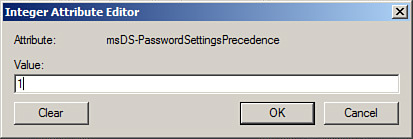Modify the precedence for the PSO.
To modify the precedence for PSOs, perform the following steps:
1. | Log on to a DC or a member computer that has Windows Server 2008 RSAT installed.
|
2. | Click Start, click Administrative Tools, and then click Active Directory Users and Computers.
|
3. | On the View menu, ensure Advanced Features is selected.
|
4. | In the console tree, expand the System node and then select the Password Settings Container node.
|
5. | In the details pane, right-click the PSO for which you want to modify the precedence; then select Properties.
|
6. | On the PSO properties page, click the Attribute Editor tab.
|
7. | Select the msDS-PasswordSettingsPrecedence attribute and click Edit.
|
8. | In the Integer Attribute Editor window, shown in Figure 1, enter the new value for the PSO Precedence, and then click OK.

|
Tip
When multiple PSOs are applied to users or global groups in AD DS, the PSO with the lowest precedence value wins.